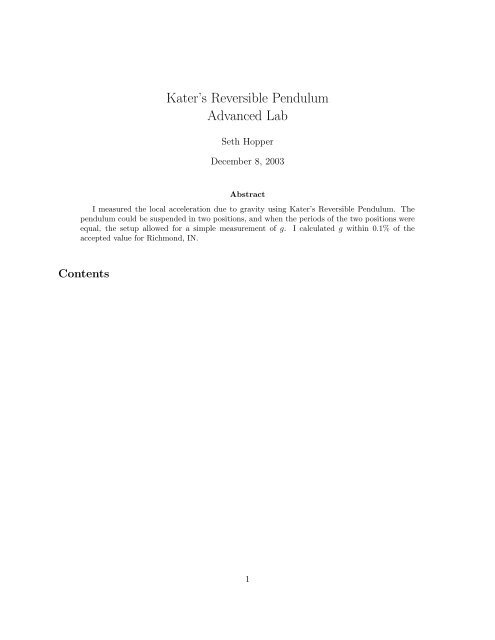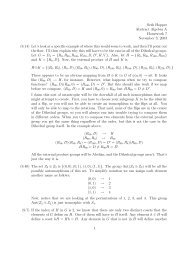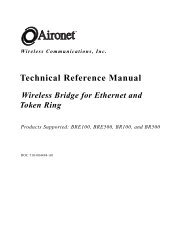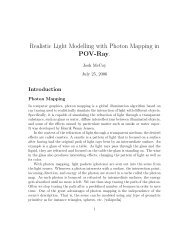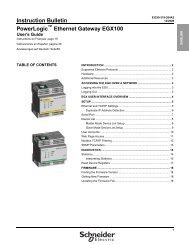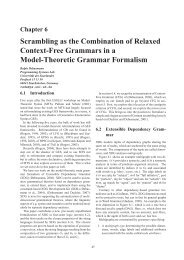Kater's Reversible Pendulum Advanced Lab - Earlham Computer ...
Kater's Reversible Pendulum Advanced Lab - Earlham Computer ...
Kater's Reversible Pendulum Advanced Lab - Earlham Computer ...
Create successful ePaper yourself
Turn your PDF publications into a flip-book with our unique Google optimized e-Paper software.
Kater’s <strong>Reversible</strong> <strong>Pendulum</strong><br />
<strong>Advanced</strong> <strong>Lab</strong><br />
Seth Hopper<br />
December 8, 2003<br />
Abstract<br />
I measured the local acceleration due to gravity using Kater’s <strong>Reversible</strong> <strong>Pendulum</strong>. The<br />
pendulum could be suspended in two positions, and when the periods of the two positions were<br />
equal, the setup allowed for a simple measurement of g. I calculated g within 0.1% of the<br />
accepted value for Richmond, IN.<br />
Contents<br />
1
1 Introduction<br />
The local acceleration due to gravity is perhaps the most commonly used constant in all physics<br />
calculations. It can be measured many different ways, some with more accuracy than others. The<br />
method I used in this lab involved a reversible pendulum, developed by Kater in 1817.<br />
Kater’s reversible pendulum is a physical pendulum with movable masses on either end, as<br />
depicted in Figure<br />
2 Theory<br />
In order to motivate the use of the reversible pendulum, we consider the scenario depicted in Figure<br />
2. We assume that the masses M 1 and M 2 have been positioned as to make the periods of the two<br />
Figure 1:<br />
orientations of the pendulum equal. Here the physical pendulum is suspended from a knife edge<br />
at point P 1 . The center of mass is at point C, and the distance between these two points is, as<br />
displayed, h 1 . Let the total mass of the pendulum be M and the moment of inertia about point P 1<br />
2
e I P1 . Then, the torque on the pendulum from gravity is<br />
τ = I P1<br />
d 2 θ<br />
dt 2 = −Mgh 1 sin(θ). (1)<br />
For our purposes, let us only consider cases when θ is small; then we can make the approximation<br />
sin(θ) = θ. Then the period for this physical pendulum becomes<br />
√<br />
I P1<br />
T = 2π . (2)<br />
Mgh 1<br />
Now, we recognize that from the parallel axis theorem that<br />
I P1 = I C + Mh 2 1 (3)<br />
where I C , is the moment of inertia about the center of mass of the pendulum. At this point we<br />
define the radius of gyration k of the pendulum about C to be<br />
k = √ I C /M. (4)<br />
Hence, Equation<br />
. We assume that the masses M 1 and M 2 have been positioned as to make the periods of the<br />
two orientations of the pendulum equal. Here the physical pendulum is suspended from a knife<br />
edge at point P 1 . The center of mass is at point C, and the distance between these two points is,<br />
as displayed, h 1 . Let the total mass of the pendulum be M and the moment of inertia about point<br />
P 1 be I P1 . Then, the torque on the pendulum from gravity is<br />
τ = I P1<br />
d 2 θ<br />
dt 2 = −Mgh 1 sin(θ). (5)<br />
For our purposes, let us only consider cases when θ is small; then we can make the approximation<br />
3
Figure 2:<br />
sin(θ) = θ. Then the period for this physical pendulum becomes<br />
√<br />
I P1<br />
T = 2π . (6)<br />
Mgh 1<br />
Now, we recognize that from the parallel axis theorem that<br />
I P1 = I C + Mh 2 1 (7)<br />
where I C , is the moment of inertia about the center of mass of the pendulum. At this point we<br />
define the radius of gyration k of the pendulum about C to be<br />
k = √ I C /M. (8)<br />
Hence, Equation<br />
4
3 Procedure<br />
The key to measuring the acceleration due to gravity with Kater’s reversible pendulum is finding<br />
a positioning where the period is identical when the pendulum is flipped vertically and suspended<br />
from the other knife edge. In finding this position, I used the following equipment.<br />
3.1 Equipment<br />
1. EM-12 Kater’s <strong>Reversible</strong> <strong>Pendulum</strong> with stable wall mount<br />
2. PASCO Scientific Photogate<br />
3. Apple <strong>Computer</strong> running Science Workshop<br />
4. <strong>Lab</strong> Jack Adjustable Stand<br />
5. 2 Meter Stick<br />
6. Calipers<br />
7. Straight Blade Screwdriver<br />
3.2 In General<br />
I set up the equipment as shown in Figure<br />
Figure 3:<br />
The equipment setup for measuring periods of the Kater pendulum.<br />
5
There are many different orientations that will yield equal upright and inverted periods for the<br />
Kater pendulum. In fact, for every position of M 1 there is one position of M 2 where the periods will<br />
be identical. I placed M 1 at one position and moved M 2 , making measurements every 5 cm until<br />
the periods were equal. Then I took more accurate measurements of the position of M 2 , moving it<br />
only 2 cm at a time in the range where I found the periods to be equal.<br />
3.3 The Specifics<br />
I hung the pendulum from the wall mount with M 1 at the top. Using the adjustable stand, I placed<br />
the photogate directly underneath the bottom of the pendulum so that when the pendulum was at<br />
its minimum it blocked the signal between the two sensors of the photogate. When the pendulum<br />
would oscillate the photogate would report every time the signal was interrupted, which was every<br />
half period. These signals were sent to the computer running Science Workshop software, which<br />
measured the time intervals between interrupts. These intervals were displayed on the screen, and<br />
I observed them for many different positions of M 1 2 .<br />
I started M 2 78 cm from the bottom of the pendulum (as oriented in Figure<br />
4 Results and Conclusions<br />
The following graphs display the periods of the Kater reversible pendulum in both orientations as<br />
a function of the position of M 2 . The intersection of the lines indicates the position where the<br />
periods for the different orientations of the pendulum are equal. The second graph is basically a<br />
zoom of the first graph, and I see that the intersection occurs at 2.006 s.<br />
The formula for g comes<br />
from Equation<br />
How accurate is this Well, a formula for the local acceleration due to gravity is as follows.<br />
g = 9.780 318 4(1 + 0.005 302 4 sin 2 L − 0.000 005 9 sin 2 2L) − 3.086 × 10 −6 H (9)<br />
Here L is the latitude and H is the height above sea level. For Richmond, IN the latitude is 39.83 ◦<br />
1 The computer actually displayed whole periods, not half periods, so it only output data every other signal<br />
interrupt.<br />
6
2.06<br />
2.04<br />
2.02<br />
”Up”<br />
”Down”<br />
2<br />
1.98<br />
Period (s)<br />
1.96<br />
1.94<br />
1.92<br />
1.9<br />
1.88<br />
1.86<br />
0<br />
0.1<br />
0.2<br />
0.3 0.4 0.5<br />
M2 Position (cm)<br />
0.6<br />
0.7<br />
0.8<br />
2.06<br />
2.05<br />
”Up Zoom”<br />
”Down Zoom”<br />
2.04<br />
Period (s)<br />
2.03<br />
2.02<br />
2.01<br />
2<br />
0<br />
0.02<br />
0.04<br />
0.06 0.08 0.1<br />
M2 Position (cm)<br />
0.12<br />
0.14<br />
0.16<br />
and the elevation is 286.2 m. Hence, the local acceleration due to gravity should be<br />
g = 9.780 318 4(1 + 0.005 302 4 sin 2 (39.83) − (10)<br />
5.9 × 10 −6 sin 2 (2 · 39.83)) − 3.086 × 10 −6 · 286.2<br />
7
g = 9.801 m/s 2 . (11)<br />
The acceptable range for my result is<br />
9.637 m/s 2 ≤ g ≤ 9.985 m/s 2 . (12)<br />
Clearly the accepted value for g falls well within this range. In fact, my result is barely .1% off<br />
from the accepted value. Perhaps my range of uncertainty is too large. However, I do believe that<br />
the uncertainty in H is accurate. It would not surprise me, on the other hand, if the uncertainty<br />
in T were smaller than I estimated.<br />
In conclusion, I conclude that the data I took from the reversible Kater pendulum gave conclusive<br />
results that concur with those taken by other people in this world. The possible reasons for<br />
differences between my results and the accepted values include that my elevation and latitude are<br />
probably not exactly what I found by searching on the Internet. Also, there could be local mineral<br />
deposits that could alter the local value of g from what would be accepted. I ignored any friction,<br />
and also made the approximation that sin(θ) = θ, but I doubt if either of these played a role in<br />
any inaccuracies. If I had to guess, and I do, I think the uncertainties in T and H were mostly<br />
responsible for the majority of my discrepancy.<br />
8


